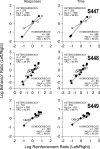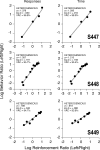Concurrent schedules of positive and negative reinforcement: differential-impact and differential-outcomes hypotheses
- PMID: 18683609
- PMCID: PMC2441574
- DOI: 10.1901/jeab.2008.90-1
Concurrent schedules of positive and negative reinforcement: differential-impact and differential-outcomes hypotheses
Abstract
Considerable evidence from outside of operant psychology suggests that aversive events exert greater influence over behavior than equal-sized positive-reinforcement events. Operant theory is largely moot on this point, and most operant research is uninformative because of a scaling problem that prevents aversive events and those based on positive reinforcement from being directly compared. In the present investigation, humans' mouse-click responses were maintained on similarly structured, concurrent schedules of positive (money gain) and negative (avoidance of money loss) reinforcement. Because gains and losses were of equal magnitude, according to the analytical conventions of the generalized matching law, bias (log b (double dagger) 0) would indicate differential impact by one type of consequence; however, no systematic bias was observed. Further research is needed to reconcile this outcome with apparently robust findings in other literatures of superior behavior control by aversive events. In an incidental finding, the linear function relating log behavior ratio and log reinforcement ratio was steeper for concurrent negative and positive reinforcement than for control conditions involving concurrent positive reinforcement. This may represent the first empirical confirmation of a free-operant differential-outcomes effect predicted by contingency-discriminability theories of choice.
Figures


Similar articles
-
Comparing pleasure and pain: the fundamental mathematical equivalence of reward gain and shock reduction under variable interval schedules.J Exp Anal Behav. 2012 Nov;98(3):355-67. doi: 10.1901/jeab.2012.98-355. J Exp Anal Behav. 2012. PMID: 23144510 Free PMC article.
-
Are positive and negative reinforcement "different"? Insights from a free-operant differential outcomes effect.J Exp Anal Behav. 2017 Jan;107(1):39-64. doi: 10.1002/jeab.243. J Exp Anal Behav. 2017. PMID: 28101928
-
Concurrent schedules of differential reinforcement of alternative behavior in the treatment of problem behavior without extinction.J Appl Behav Anal. 2023 Jun;56(3):623-637. doi: 10.1002/jaba.987. Epub 2023 Apr 23. J Appl Behav Anal. 2023. PMID: 37088926
-
Operant conditioning.Annu Rev Psychol. 2003;54:115-44. doi: 10.1146/annurev.psych.54.101601.145124. Epub 2002 Jun 10. Annu Rev Psychol. 2003. PMID: 12415075 Free PMC article. Review.
-
Theory of reinforcement schedules.J Exp Anal Behav. 2023 Nov;120(3):289-319. doi: 10.1002/jeab.880. Epub 2023 Sep 14. J Exp Anal Behav. 2023. PMID: 37706228 Review.
Cited by
-
Comparing pleasure and pain: the fundamental mathematical equivalence of reward gain and shock reduction under variable interval schedules.J Exp Anal Behav. 2012 Nov;98(3):355-67. doi: 10.1901/jeab.2012.98-355. J Exp Anal Behav. 2012. PMID: 23144510 Free PMC article.
-
Effects of and preference for conditions of token earn versus token loss.J Appl Behav Anal. 2014 Fall;47(3):537-48. doi: 10.1002/jaba.135. Epub 2014 May 21. J Appl Behav Anal. 2014. PMID: 24844817 Free PMC article.
-
Telepractice for pediatric Dysphagia: a case study.Int J Telerehabil. 2014 Sep 3;6(1):3-16. doi: 10.5195/ijt.2014.6135. eCollection 2014 Spring. Int J Telerehabil. 2014. PMID: 25945217 Free PMC article.
-
Learning Channels: The Role of Compound Stimuli in the Emergence of Intraverbal Relations in Children on the Autism Spectrum.Anal Verbal Behav. 2021 Feb 18;37(1):97-122. doi: 10.1007/s40616-020-00142-1. eCollection 2021 Jun. Anal Verbal Behav. 2021. PMID: 34395168 Free PMC article.
-
The generalized matching law in elite sport competition: football play calling as operant choice.J Appl Behav Anal. 2006 Fall;39(3):281-97. doi: 10.1901/jaba.2006.146-05. J Appl Behav Anal. 2006. PMID: 17020210 Free PMC article.
References
-
- Baker F, Johnson M.W, Bickel W.K. Delay discounting in current and never-before cigarette smokers: Similarities and differences across commodity, sign, and magnitude. Journal of Abnormal Psychology. 2003;112:382–392. - PubMed
-
- Baron A. Avoidance and punishment. In: Iversen I.H, Lattal K.A, editors. Experimental analysis of behavior, Part 1. Amsterdam: Elsevier; 1991. pp. 173–217.
Publication types
MeSH terms
LinkOut - more resources
Full Text Sources

